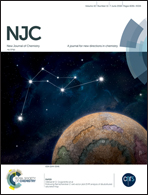Photoswitchable azobenzene–rhodamine tweezers for biosensing of Al3+ ions†
Abstract
Dominant excited state photochemical deactivation over the radiative decay pathway of azobenzene enables this molecule to be non-fluorescent despite its rich π-conjugation. Partial or complete control over the photoisomerization reaction is indispensable in making this molecule fluorescent. To control the excited state properties of azobenzene, we have covalently coupled it with a spirocyclic rhodamine unit through a p-phenylmethanimine bridge. While the characteristic weak fluorescence and trans → cis photoisomerization of azobenzene have not been affected by spirocyclic rhodamine, selective Al3+ ion induced spirocyclic ring opening prevents the photoisomerization with a concomitant enhancement in fluorescence. This process is reversed by the addition of a F− ion. The occurrence of fluorescence resonance energy transfer (FRET) from azobenzene to rhodamine and light catalyzed spirocyclic ring opening reactions underscore that the azobenzene excited state can be altered without affecting its core structure. Indeed, the light catalyzed ring opening reaction helps to enhance the signal intensity, which would be advantageous in detecting Al3+ ions at lower concentrations. The applicability of the probe has been tested in prokaryotic and eukaryotic cell lines, where turn-on, intense fluorescence in the presence of Al3+ ions was observed.



 Please wait while we load your content...
Please wait while we load your content...